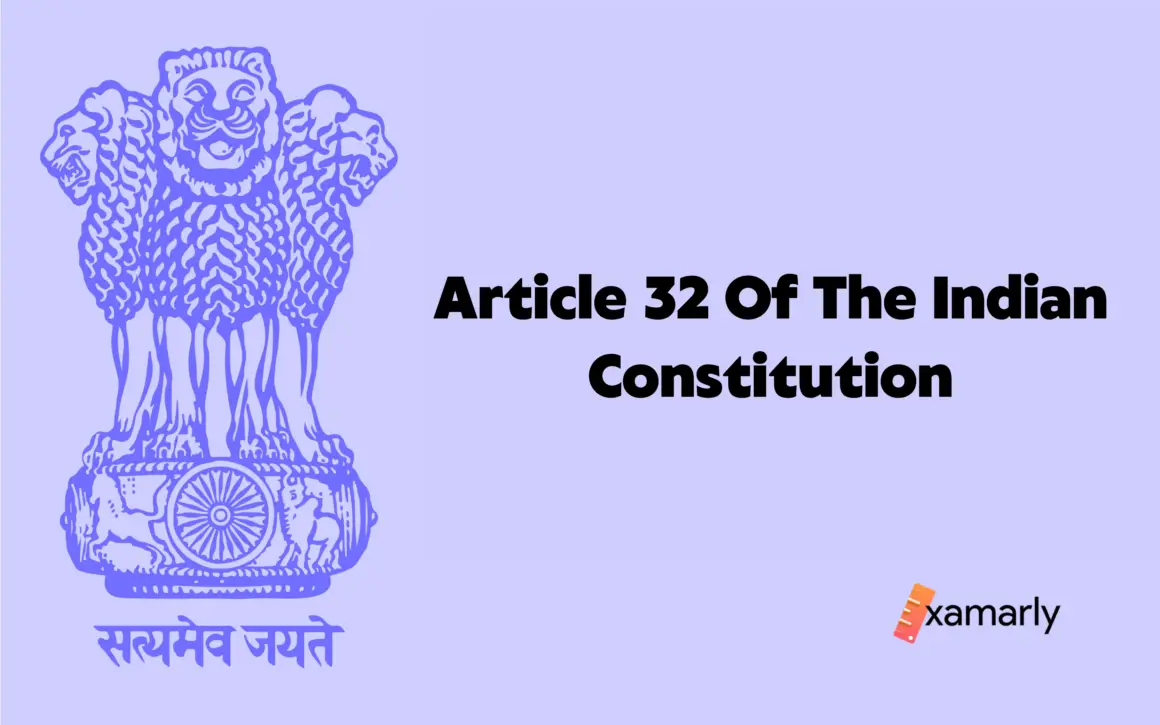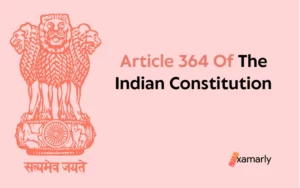Article 32 among other important articles aimed to eradicate lack of jurisdiction in the country as much as possible. If you’re looking for a summary of Article 32 of the Indian Constitution, you’ve come to the right place. This article describes the various features of this important article. You’ll learn about the Writ, Habeas Corpus, and Certiorari. Moreover, you’ll learn how to get a Writ in India. You will also learn about how the Article 32 of the Indian constitution made constitutional remedies achievable for everyone in the country.
Article 32 Of The Indian Constitution – Core Idea And Goal
According to Article 32 of the Indian Constitution, people have the right to appeal the Supreme Court for justice if they believe their rights have been “unduly deprived.” Given that it is regarded as “the custodian and guarantor of Fundamental Rights,” the Supreme Court is given the power to issue instructions or orders for the implementation of any of the rights guaranteed by the Constitution.
In accordance with Article 32, the parliament may also assign any other court the responsibility of carrying out the Supreme Court’s authority, so long as the court falls under its purview. The rights granted by this Article also cannot be suspended lacking a constitutional revision. Since the law facilitates an individual the right to fetch Supreme Court directly, rather than going through the more time-consuming process of first going through lower courts, we can conclude that this article guarantees individuals an assured right to the enforcement of their fundamental rights. This is because the main goal of Writ Jurisdiction under Article 32 is the enforcement of Fundamental Rights.
Features Of Article 32 Of the Indian Constitution
- Under Article 32 Remedy is guaranteed.
- Under Article 32 Supreme Court and High Courts have the authority to grant Writ.
- Parliament can grant authority to other courts as well for issuing writs
- Supreme Court which is responsible for protecting India’s fundamental rights can suspend any of the fundamental rights under article 32.
What Is A Writ?
A writ is a formal written order from the court. The official order may take the form of a warrant, instruction, command, or other documents. Only the High Court and the Supreme Court are authorized to issue writs under Articles 226 and 32 of the Indian Constitution of 1950, respectively. Prerogative writs are a legal doctrine that the Indian Constitution adopted from English common law.
A written order from the King was the original meaning of the word “writes.” However, in England, these writs are now open to anybody who feels wronged by a ruling from a lower court or administrative authority.
When writs and orders are compared, it may be claimed that writs can be issued in situations when the aggrieved party is seeking an extraordinary remedy, typically against an administrative action, whereas orders can be passed in any situation. Law provides for 5 different sorts of writs, but orders have not been given a similar classification.
As a result, all writs can be referred to as orders, but all orders cannot be referred to as writs because orders have a wider scope than writs.
Types Of Writs
The writ jurisdiction was introduced by Dr. B.R Ambedkar. According to Indian constitution law, there are 5 different types of writs that are being provided for the citizen of India.
Habeas Corpus
The major goal of this writ is to assert a claim against an individual’s wrongful imprisonment. Its goal is to safeguard a person against unjustified harm brought on by the administrative system. It safeguards the rights of individuals in the aspect of proving whether or not they are actually guilty.
If a criminal who has been found guilty feels that he has been unlawfully imprisoned and that the conditions in which he has been confined fall below the basic legal standards for human treatment, he has the right to ask the court for help by submitting an application for a “writ of Habeas Corpus.”
The first Habeas Corpus case in India was brought by the victim’s father in Kerala after victim P. Rajan, a college student, was detained by the Kerala police and, unable to withstand the harassment and was passed away while being held in jail. It was established that he passed away while being held by the police when his father, Mr. T.V. Eachara Warrier, filed a petition for habeas corpus. This writ can also be exercised for unlawful detention under the circumstances like declared emergency by the president.
Certiorari
The writ of Certiorari is Latin for “to certify.” When there is an improper use of jurisdiction, it is issued and used as the basis for the case’s ruling. The parties who are affected by the writ may appeal it to higher courts, such as the High Court or the Supreme Court.
The enforcement of the Writ of Certiorari can be done for a number of reasons. A petition for certiorari may only be filed in response to judicial or quasi-judicial orders; it cannot be filed in response to merely administrative or ministerial orders.
The Supreme Court has outlined the intent, purview, and limitations of the writ of Certiorari in Surya Dev Rai v. Ram Chander Rai & Ors. Additionally, it was explained in this that a High Court cannot grant a Certiorari against any High Court or benches, much less the Supreme Court and any of its benches, as it is always available only against lower courts and not against equal or higher courts.
Prohibition
It is a writ ordering a lower court to cease acting in a manner that is against the law. Its major goal is to stop a lower court from operating outside of Natural Justice’s norms or exceeding its authority.
In the case of East India Commercial Co. Ltd v. Collector of Customs, a writ of prohibition was issued directing a subordinate Tribunal to stop it from continuing the procedure on the grounds that it is outside of its purview, exceeds its authority, or otherwise violates the law.
Mandamus
The Latin for “Writ of Mandamus” is “We Command.” This writ, which is issued by a superior court to a lower court or government official, is issued for the proper discharge of obligatory and purely ministerial tasks. The President and the Governor cannot be served with this writ, nevertheless. Its principal goal is to make sure that the executive branch or administration does not abuse its authority or perform its obligations improperly.
Additionally, it protects the general public against administrative organizations abusing their power. The mandamus “is neither a writ of right nor of course, but that it will be issued if the duty is in the character of public duty and it especially affects the right of an individual, provided there is no other appropriate remedy”. A mandamus petitioner must be certain that he has the legal authority to order the opposing party to do or refrain from doing something.
According to the ruling in Rashid Ahmad v. Municipal Board, the existence of an alternative remedy cannot exclude the issuance of a writ in accordance with fundamental rights, even though this fact may be taken into account.
The publisher of a book then requested a writ of mandamus against the Director of Public Instruction in the case of Manjula Manjori v. Director of Public Instruction to have his book added to the list of books that were approved as textbooks in schools. However, the writ was rejected because D.I.P. had complete discretion over the matter and was not required to endorse the book.
Quo-Warranto
The phrase “By what means” is implied by the Writ of Quo Warranto. This writ is issued to prevent people from acting in a public office to which they are not entitled. It is used in cases involving public offices. Even though the term “office” used here differs from “seat” in the legislature, a writ of quo warranto can still be issued with regard to the position of Chief Minister holding an office; however, if the petitioner is unable to demonstrate that the minister was improperly appointed or is otherwise ineligible to hold the position, a writ of quo warranto cannot be issued against a Chief Minister. It cannot be brought against a Municipal Corporation Administrator who has been nominated by the government, after its breakdown. Any person has the right to contest an appointment to public office, regardless of whether or not that person’s fundamental rights or other legal rights have been violated.
Despite the fact that Ms. Mayawati (CM) and several members of her cabinet were Rajya Sabha members, the writ of Quo Warranto against them was denied in the case of Ashok Pandey v. Mayawati.
The Nagpur High Court then noted that “In proceedings for a writ of quo warranto, the applicant does not seek to enforce any right of his as such or complain of any non-performance of duty towards him.” This was in the case of G.D. Karkare v. T.L. Shevde. The non-applicants right to hold the position is in question, and a decision that is made will remove him from it.
Principle Of res judicata
Section 11 of the Civil Procedure Code of 1908 defines res judicata. Its Latin equivalent is “a matter decided.” This means that the parties to the litigation cannot bring another lawsuit based on the same claim and disagreement. Three maxims serve as the foundation for the Res Judicata principle
Read below along with their meaning
- Nemo debet lis vaxari pro eadem causa- No one ought to experience the same annoyance twice.
- Interest republicae ut sit finis litium- Putting an end to lawsuits is in the state’s best interest.
- Res judicata pro veritate occipitur- A court’s judgment must be regarded as fair.
Significance Of Article 32
- The Supreme Court’s authority under Article 32 is mandatory by nature and not at the discretion of the court because it is a Fundamental Right in and of itself.
- Other than fundamental rights, no other legal right may be brought before the Supreme Court.
- Article 32’s absence from other articles that specify the Supreme Court’s General Jurisdiction is a significant element of this provision.
Article 32 Of The Indian Constitution As Interpreted By The Supreme Court Recently
In the Siddique Kappan case from 2021, the supreme court made an oral observation and inquired as to the petitioner’s justifications for not first addressing the High Court. Another petitioner was told to go before the High Court by the same Bench. The Supreme Court instructed the Bombay High Court to hear the bail plea in a petition for relief of bail filed by P. Hemalatha due to the health issues with her spouse.
In a notice of contempt sent to the Assistant Secretary of the Maharashtra Legislative Assembly, the Supreme Court explicitly stated that the right to seek redress from the Supreme Court is a fundamental one and that “there is no doubt that if a citizen of India is discouraged in any case from petitioning this Court in exercise of his right under Article 32 of the Constitution of India would amount to serious and direct interference in the administration of justice in the country.”
The Procedure Of Filing Writs Petitions
The following process must be followed in order to file writ petitions with the Supreme Court under Article 32:
- The petitioner must present the Supreme Court with the necessary documents, such as identification, evidence of residency, photos, etc.
- The petition’s draught must include the key details as well as the name and address of the harmed party.
- Sending the Writ petition to the Supreme Court is required.
- After accepting the petition, the court will schedule the date for the petition’s hearing and, on that occasion, will notify the respondent. The hearing for both sides has a new date set.
- Following a hearing with both parties, the court renders a decision and grants a remedy.
The Amendment It Is Related To
Article 32 now contains “anti-freedom” clauses due to the 42nd Amendment. When such an amendment was passed, it was done so to limit the Supreme Court’s and the High Courts’ ability to assess how fundamental rights were being applied, “both directly and indirectly.”
The Indian Constitution’s 43rd amendment was then approved, repealing Article 32A as soon as the state of emergency was over. After the amendment, the Supreme Court was once more able to overturn state laws. The High Court now has the authority to challenge the constitutionality of national laws.
Summing Up
Fundamental rights are given to the Supreme Court as a shield and guarantee. If these rights are violated, Article 32 of the constitution gives it the authority and authority to provide redress. It was lauded by Dr. Ambedkar as the “Heart and Soul of the Constitution” with justification. The facts mentioned above make it clear that Article 32 supports the equitable norm of natural justice. The writs also permit Public Interest Litigations to be documented for the benefit of the public at large. The arbitrary use of power must be constrained in a People’s Constitution built on the welfare state ideal. One of the original foundational elements of constitutional democracy is the Writs. All in all Article 32 of the Indian constitution enhances the basic structure of the judicial system of the country and by empowering the basic structure it ensures the minimalization of flaw in seeking constitutional remedies.
How many writs can be issued following Article 32 of the Constitution of India
There are five writs that can be issues following the Article 32 of the Indian constitution having the nature of Habeas Corpus, Mandamus, Prohibition, Certiorari, and Quo Warranto.
What is the nature of writ petition under Article 32?
The Writ Jurisdiction provided under this Article discrete.
Who can file writ under Article 32 of the Indian constitution?
Any person who is a citizen of India can file a writ petition under Article 32 if he/she finds that his/her rights has been violated.
What is difference between appeal and writ petition?
Indian constitutional and fundamental rights are protected through a writ petition. Comparatively, an appeal is basically a motion filed before a higher court after a lower court has passed a decision that is unsatisfactory to the aggrieved party.






